Total Internal
Reflection - The Basic Principle of Optical Fiber -
And Fiber Numerical Aperture
Background:
Optical Fiber
Optical fiber uses the optical principle of "total
internal reflection" to capture the light transmitted in
an optical fiber and confine the light to the core of
the fiber. An optical fiber is comprised of a
light-carrying core in the center, surrounded by a
cladding that acts to traps light in the core. Glass
fiber is covered by a plastic buffer coating that
protects it from the environment and allows easy
handling for splicing or termination.
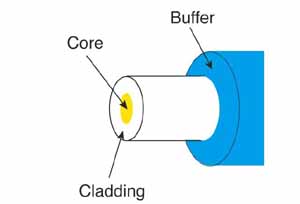
The index of refraction of glass or any optical material
is a measure of the speed of light in the material and
changes in index of refraction are what causes light to
bend - as shown in this photo of a plastic rod in a
pond:
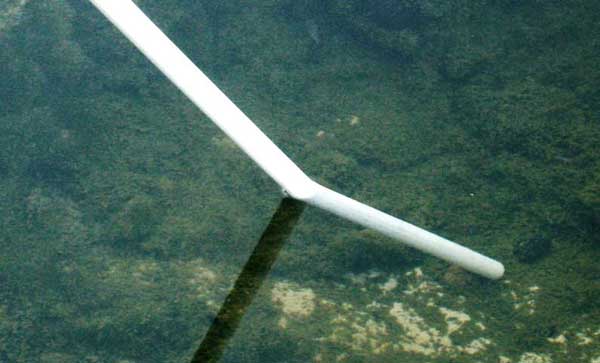
Beyond
a certain angle, the refraction will cause light to be
reflected from the surface. Optical fiber uses this
reflection to "trap" fiber in the core of the fiber by
choosing core and cladding materials with the proper
index of refraction that will cause all the light to be
reflected if the angle of the light is below a certain
angle. We call that "total internal reflection."
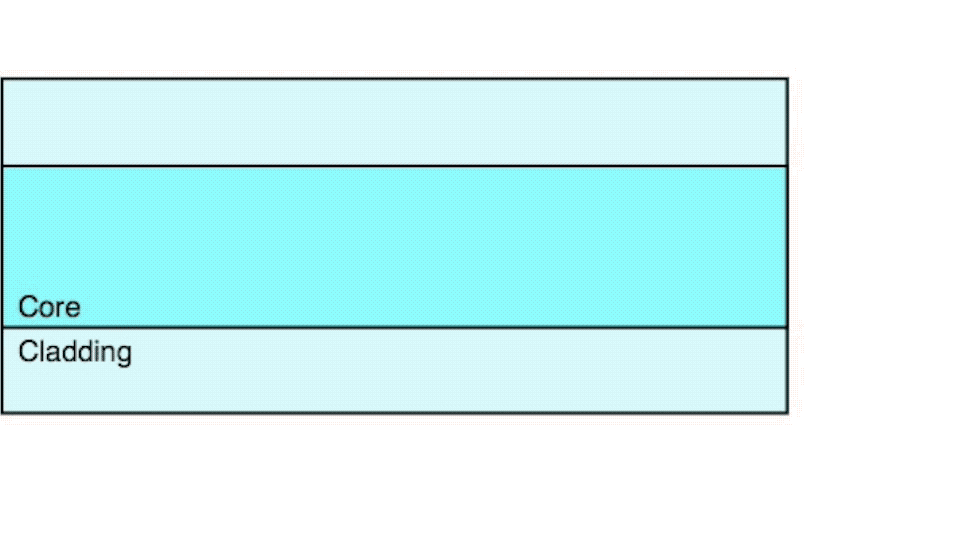
There
is an angle that for any given fiber defines total
internal reflection. At higher angles a ray of light
will still be refracted but not enough to be reflected
back into the core, so it is lost in the cladding of the
fiber. Below that angle, it will be reflected back into
the core of the fiber and transmitted to the end of the
fiber. The angle of total internal reflection defines
the "numerical aperture" (NA) of the fiber, a standard
fiber specification.
You can demonstrate this principle with a large plastic
rod (~25mm/i" diameter) and a laser pointer - a powerful
green laser works best.
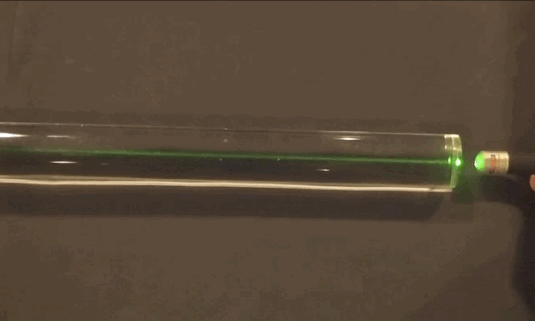
To duplicate this experiment, you need a plastic rod
(Acrylic rods ~25mm/i"
diameter are available from online sellers. The end used
for the laser needs polishing to remove the saw marks on
most commercially available rods, so first use some very
fine polishing paper (1200-3000 grit) then finish with
microfinishing polishing film (30-3 microns) or
polishing compound (toothpaste, jewelry of auto
polishing compounds.) You should end up with a
transparent end.
Total internal Reflection In Action - Step Index
Multimode Fiber
Step index multimode fiber was the first fiber
design. The core of step index multimode fiber is made
completely of one type of optical material and the
cladding is another type with different optical
characteristics. It has higher attenuation and is too
slow for many uses, due to the dispersion caused by
the different path lengths of the various modes
traveling in the core. Step index fiber is not widely
used - only POF and PCS/HCS (plastic or hard clad
silica, plastic cladding on a glass core) use a step
index design today. POF is mainly used for consumer
audio and TV links.
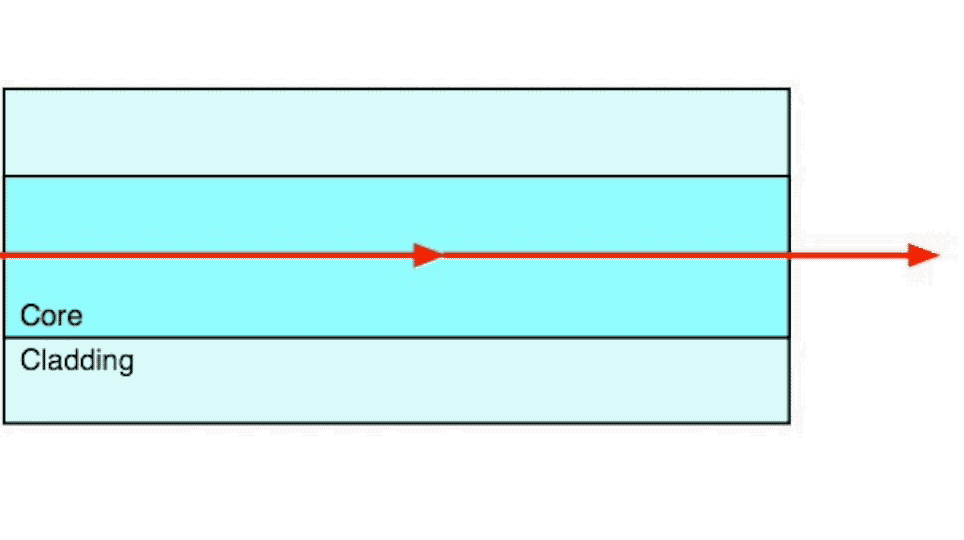
Let's Do The Physics And Math
Total internal reflection is a principle described
by Snell's Law of optics. Snell's law describes how
light bends when traveling through the boundary of two
different optical materials, such as air and water as
shown in the photo of a pole in water above. Here is the
more scientific definition.
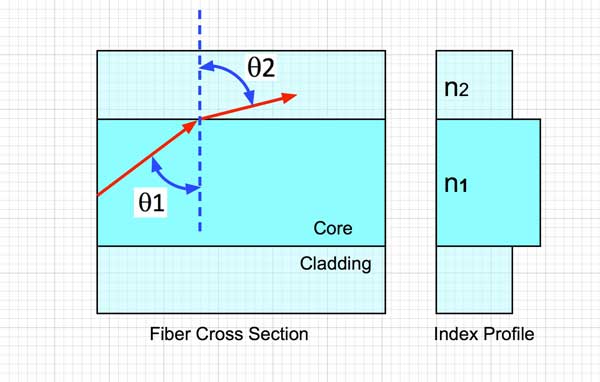
In the drawing above, the left shows a section of an
optical fiber with a ray of light. On the right is a
diagram of the index of refraction of the glass in the
fiber. The core glass is n1 and the cladding glass is
n2, and the core glass is of slightly higher refractive
index, ~1.46 to the cladding at ~1.45.

Remember basic trigonometry? The sine is the ratio of
the side of a right triangle to the hypotenuse - the
long side opposite the right angle. The refractive index
of the glass (n) is defined as the ratio of the
speed of light in a vacuum (c) to the actual speed of
light in the material (v) like this:

Using Snell's Law, we can calculate the angle at which
an optical fiber begins total internal reflection, which
happens like this drawing below, when the refracted ray
lays along the boundary between the core and the
cladding. We'll do this for a core index of 1/46 and a
cladding index of 1.45, the values we discussed above.
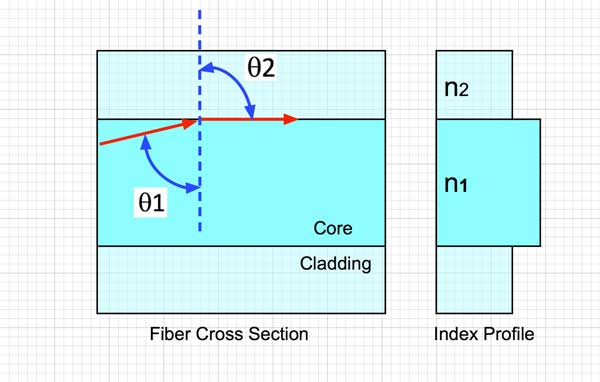
We need to manipulate the equations somewhat.
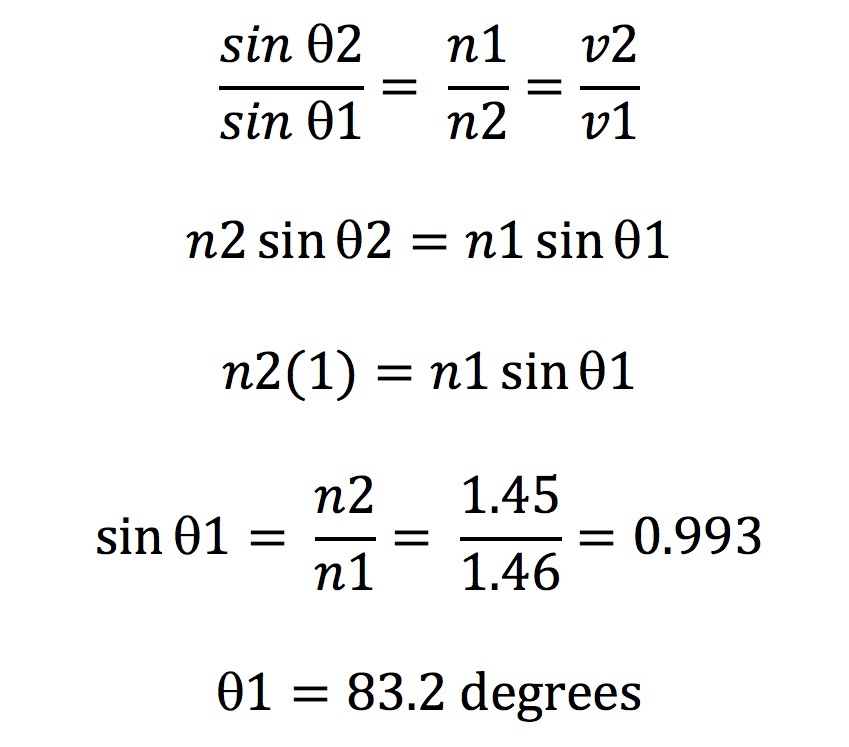
That indicates that a ray 6.8 degrees off axis (90 -
83.2 degrees) or less will see total internal
reflection. Another way of thinking about it is the
acceptance cone of the fiber is twice that angle or
about 14 degrees. This also process also defines the
definition of the NA or numerical aperture of the fiber,
but the calculation used is a mathematical manipulation
of the critical angle calculation.

The numerical aperture of an optical fiber is an
abstract term for the acceptance angle of the fiber. If
we continue using the fiber we define above, the
equation becomes:

That's
a half angle of 9.8 degrees when used to calculate the
angle - the total cone angle is ~20 degrees..
Table of
Contents: The FOA Reference Guide To Fiber Optics
|
